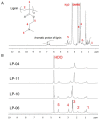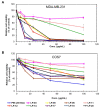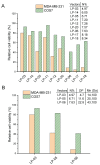Lignin-Based Nonviral Gene Carriers Functionalized by Poly[2-(Dimethylamino)ethyl Methacrylate]: Effect of Grafting Degree and Cationic Chain Length on Transfection Efficiency
- PMID: 35053250
- PMCID: PMC8773503
- DOI: 10.3390/biom12010102
Lignin-Based Nonviral Gene Carriers Functionalized by Poly[2-(Dimethylamino)ethyl Methacrylate]: Effect of Grafting Degree and Cationic Chain Length on Transfection Efficiency
Abstract
Lignin is a natural renewable biomass resource with great potential for applications, while its development into high value-added molecules or materials is rare. The development of biomass lignin as potential nonviral gene delivery carriers was initiated by our group through the "grafting-from" approach. Firstly, the lignin was modified into macroinitiator using 2-bromoisobutyryl bromide. Then cationic polymer chains of poly[2-(dimethylamino)ethyl methacrylate] (PDMAEMA) were grown from the lignin backbone using atom transfer radical polymerization (ATRP) to yield lignin-PDMAEMA graft copolymers (LPs) with branched structure. To gain a deep understanding of the relationship between the nonviral gene transfection efficiency of such copolymers and their structural and compositional factors, herein eight lignin-based macroinitiators with different modification degrees (MDs, from 3.0 to 100%) were synthesized. Initiated by them, a series of 20 LPs were synthesized with varied structural factors such as grafting degree (GD, which is equal to MD, determining the cationic chain number per lignin macromolecule), cationic chain length (represented by number of repeating DMAEMA units per grafted arm or degree of polymerization, DP) as well as the content of N element (N%) which is due to the grafted PDMAEMA chains and proportional to molecular weight of the LPs. The in vitro gene transfection capability of these graft copolymers was evaluated by luciferase assay in HeLa, COS7 and MDA-MB-231cell lines. Generally, the copolymers LP-12 (N% = 7.28, MD = 36.7%, DP = 13.6) and LP-14 (N% = 6.05, MD = 44.4%, DP = 5.5) showed good gene transfection capabilities in the cell lines tested. Overall, the performance of LP-12 was the best among all the LPs in the three cell lines at the N/P ratios from 10 to 30, which was usually several times higher than PEI standard. However, in MDA-MB-231 at N/P ratio of 30, LP-14 showed the best gene transfection performance among all the LPs. Its gene transfection efficiency was ca. 11 times higher than PEI standard at this N/P ratio. This work demonstrated that, although the content of N element (N%) which is due to the grafted PDMAEMA chains primarily determines the gene transfection efficiency of the LPs, it is not the only factor in explaining the performance of such copolymers with the branched structure. Structural factors of these copolymers such as grafting degree and cationic chain length could have a profound effect on the copolymer performance on gene transfection efficiency. Through carefully adjusting these factors, the gene transfection efficiency of the LPs could be modulated and optimized for different cell lines, which could make this new type of biomass-based biomaterial an attractive choice for various gene delivery applications.
Keywords: PDMAEMA; atom transfer radical polymerization; graft copolymer; lignin; nonviral gene carriers; plasmid DNA.
Conflict of interest statement
The authors declare no conflict of interest.
Figures











References
-
- Thakur V.K., Thakur M.K., Raghavan P., Kessler M.R. Progress in Green Polymer Composites from Lignin for Multifunctional Applications: A Review. ACS Sustain. Chem. Eng. 2014;2:1072–1092. doi: 10.1021/sc500087z. - DOI
-
- Katahira R., Elder T.J., Beckham G.T. Lignin Valorization: Emerging Approaches. The Royal Society of Chemistry; London, UK: 2018. Chapter 1 A Brief Introduction to Lignin Structure; pp. 1–20.
Publication types
MeSH terms
Substances
LinkOut - more resources
Full Text Sources
Research Materials
Miscellaneous

